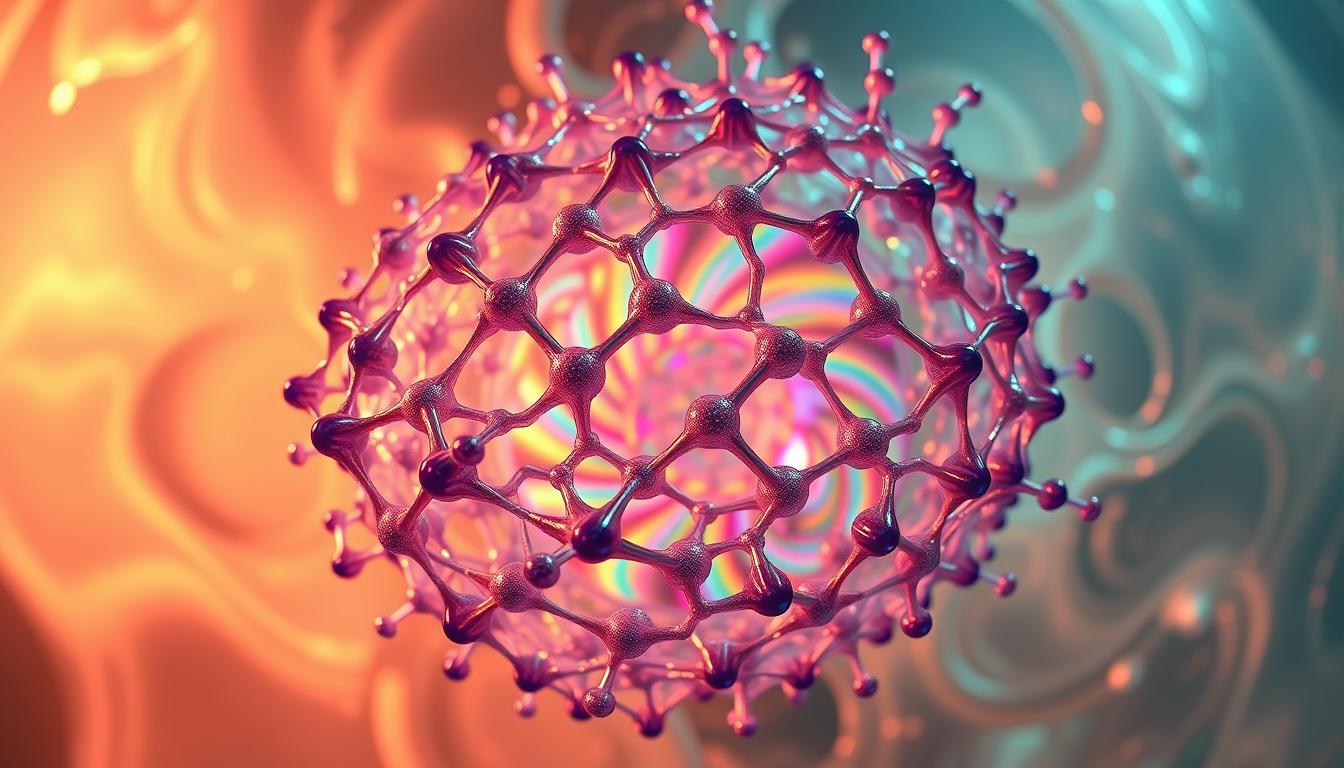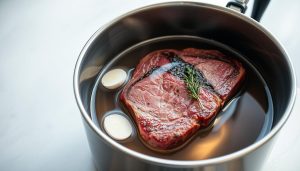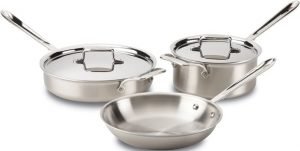What if we told you the same material that makes desserts jiggle can hold 10 times its weight in water? This protein-based substance forms the backbone of countless treats, yet few realize its molecular magic. At room temperature, it behaves like a liquid. Chill it, and it transforms into a resilient, transparent structure that defies expectations.
The key lies in its unique polymer chains. When dissolved in warm water, these strands unwind and bond with surrounding molecules. As temperatures drop, they reorganize into a three-dimensional lattice that traps liquid within. This process creates the familiar wobble while demonstrating core physics principles.
You’ll find this hydrocolloid material in more than just sweets. Its ability to stabilize and thicken makes it invaluable in products ranging from vitamins to cosmetics. The science behind its behavior reveals how simple ingredients achieve extraordinary feats through precise molecular teamwork.
Key Takeaways
- Protein chains create flexible networks when cooled
- Hydrogen bonds enable water absorption up to 10x material weight
- Temperature changes trigger structural transformations
- Molecular interactions explain texture and resilience
- Applications span food, medicine, and manufacturing
Understanding the Basics of Gelatin and Its Role in Food
Behind the scenes of countless recipes lies a versatile ingredient with surprising origins. This kitchen staple starts as collagen—a structural protein found in skin, bones, and connective tissues. Through careful processing, it becomes a clear, flavorless powerhouse that shapes textures in everything from marshmallows to soups.
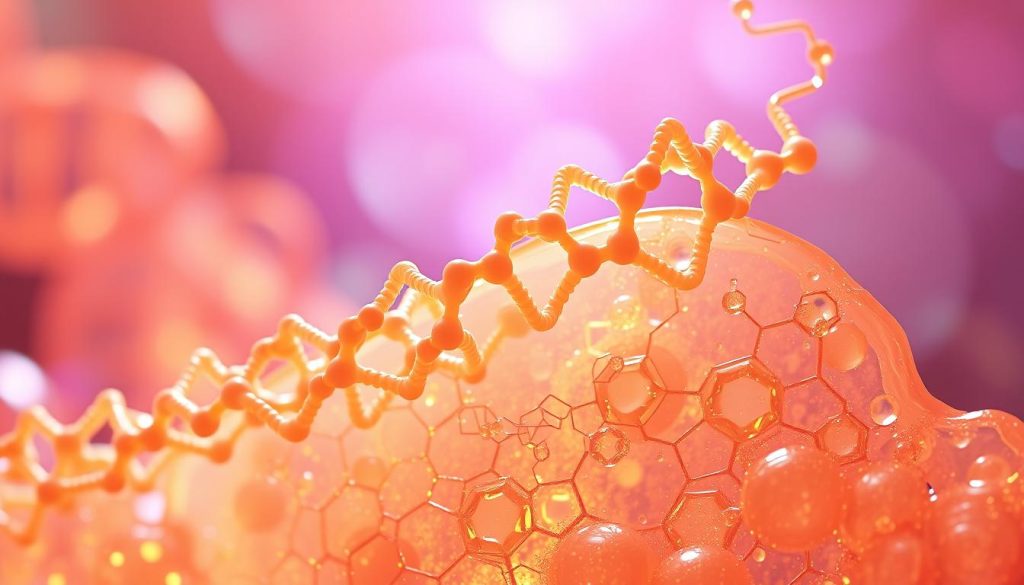
What Is Gelatin?
Derived primarily from pigs and cows, this material forms when collagen undergoes controlled breakdown. Manufacturers extract it from animal parts like hooves and bones through heating and filtration. The result? A pure protein that dissolves in hot water and sets into elastic gels when cooled.
The Science Behind Protein and Collagen
Collagen’s triple-helix structure gives skin elasticity and strengthens bones. When processed, these helices unwind into single protein strands. These strands contain amino acids like glycine and proline, which form new bonds as temperatures change.
Your body recognizes these proteins as familiar building blocks. This explains why the material blends seamlessly into foods without altering taste. Its neutral profile makes it ideal for both sweet and savory dishes.
In food production, this ingredient stabilizes textures while retaining moisture. Chefs value its ability to create smooth consistencies without adding flavors or colors. From glossy dessert toppings to clear broths, it works invisibly to perfect mouthfeel.
Exploring Cold Chemistry in Action
Temperature shifts unlock hidden molecular patterns in common kitchen ingredients. Watch what happens when heat meets a protein-based powder – the results defy everyday expectations.
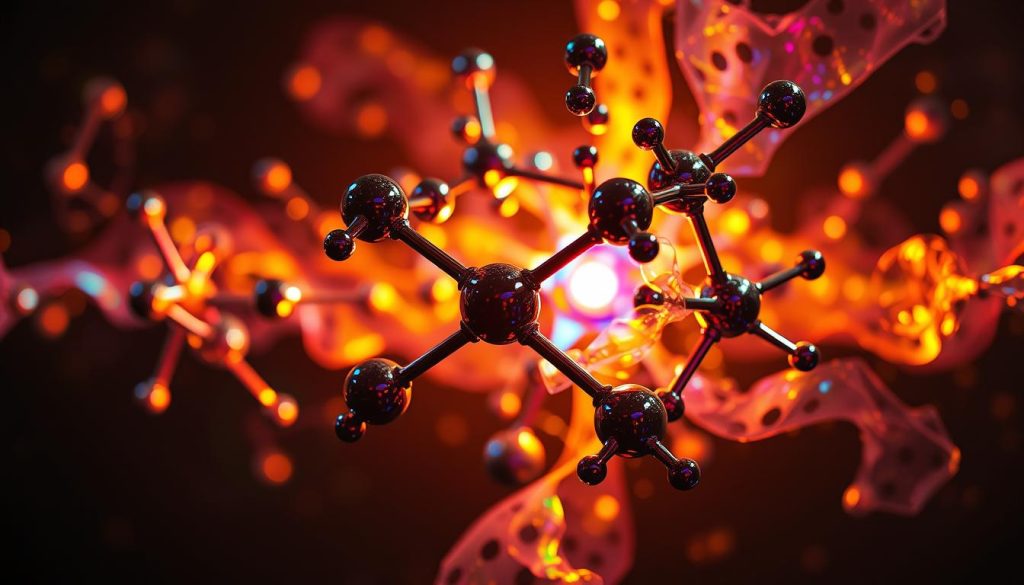
Thermal Triggers in Motion
Pouring hot water over powdered protein starts a chain reaction. Heat energy disrupts weak connections between amino acid strands, letting them stretch freely. This unwinding creates a liquid base ready for shaping.
As the mixture cools, molecular teamwork begins. Strands twist into organized patterns, rebuilding connections that trap moisture. The longer this phase lasts, the stronger the final structure becomes.
| Process | Molecular Change | Result |
|---|---|---|
| Hot Water Added | Bonds break, strands separate | Liquid state forms |
| Cooling Begins | Partial bond reformation | Initial thickening |
| Full Cooling | 3D network completion | Stable gel forms |
Timing proves critical during these phase changes. Rapid cooling creates smaller molecular networks, while gradual temperature drops allow expansive frameworks. Both methods impact texture and resilience differently.
Understanding this thermal dance helps explain why some desserts hold their shape while others collapse. The interplay between heat application and cooling rates directly determines final product success.
The Molecular Dynamics of Gelatin Jiggles
Imagine a microscopic scaffold giving shape to your favorite desserts. This framework relies on precise molecular relationships that transform liquid into elastic solids. Three key elements work together: long protein strands, strategic bonds, and organized spatial patterns.
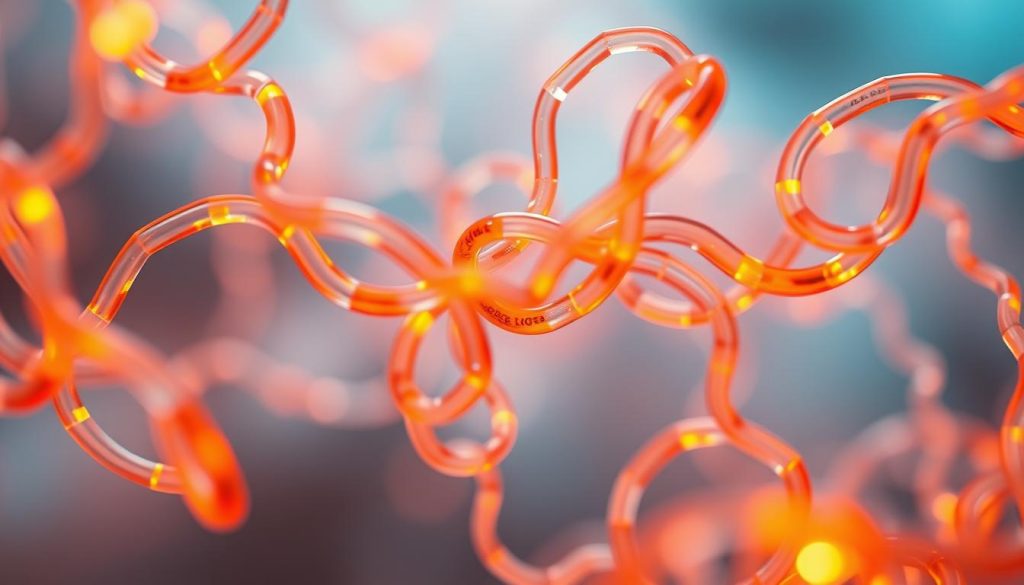
Polymer Chains and Network Formation
Protein strands stretch like interconnected highways when dissolved in liquid. These polymers reorganize as temperatures drop, weaving through the mixture like thread through fabric. Their length allows them to bridge the entire gel, creating pockets that trap water.
Randomly dispersed segments lock into place during cooling. This forms a cohesive 3D lattice that resists collapse. The result? A flexible yet stable architecture that maintains its form under pressure.
Role of Hydrogen Bonds in Stability
Weak but numerous connections between chains act like molecular Velcro. Hydrogen bonds form where amino acids align, reinforcing the network at critical points. More bonds mean greater structural integrity – think steel beams in a skyscraper.
These temporary links allow slight movement without breaking. This explains why gels wobble instead of shattering. Bond density determines whether your dessert holds its shape or turns into soup at room temperature.
Gelatin’s Versatility in Food and Beyond
Ever wondered what gives gummy bears their chew or soups their silky finish? This multifunctional ingredient works behind the scenes across industries, mastering textures while remaining invisible to taste buds.
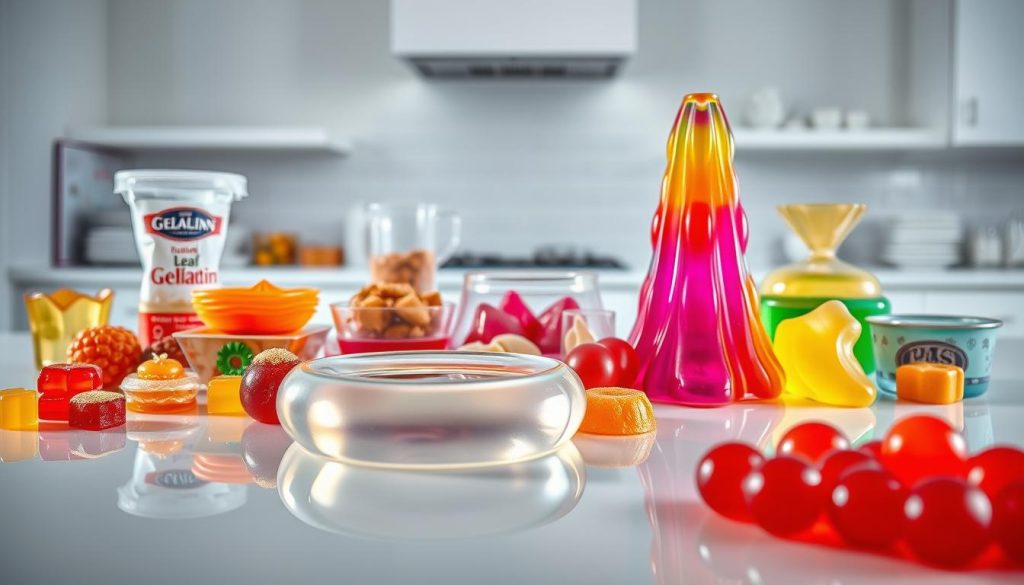
Applications in Desserts and Soups
Your favorite desserts rely on this protein to achieve perfect consistency. It stabilizes fluffy marshmallows, creates bounce in jellies, and prevents ice cream from forming gritty crystals. Even creamy puddings gain their smoothness through its water-binding magic.
In savory dishes, it transforms broths into velvety soups without altering flavors. Chefs use it to clarify consommés and thicken sauces, while home cooks appreciate its ability to set dips and spreads. The same properties make it essential in low-fat food products that mimic rich textures.
Beyond the kitchen, this ingredient shapes capsules for medicines and gives body to shampoos. Forensic experts even use it to create realistic wound simulations for crime scene training. Its adaptability stems from an unmatched ability to modify textures while remaining neutral-tasting and easy to use.
From Powder to Pudding: The Transformation Process
Unlocking the potential of a humble powder requires just two elements: heat and time. This kitchen staple begins as dehydrated crystals that hold the blueprint for texture transformation. When activated correctly, it creates everything from silky custards to firm molded desserts.
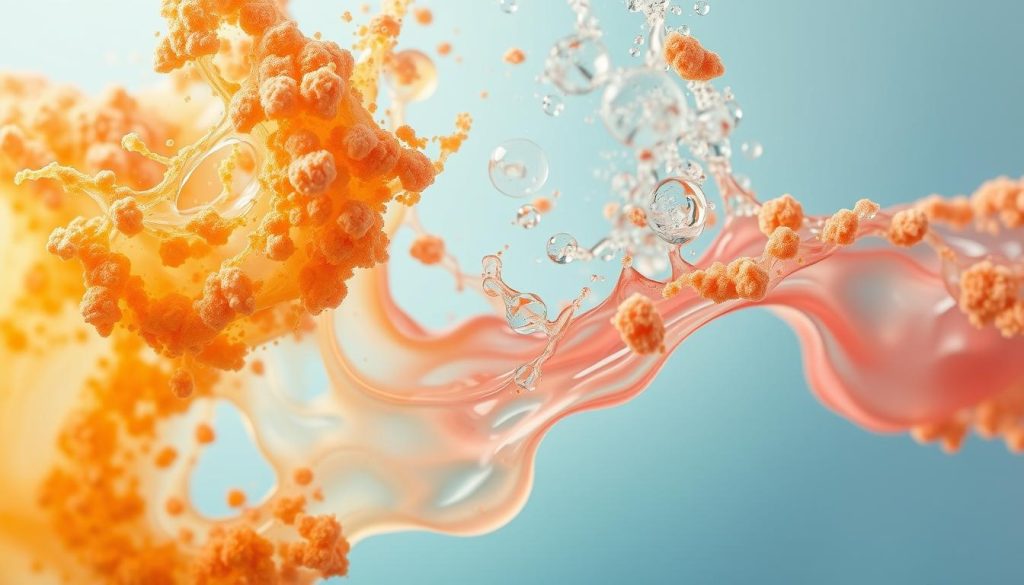
Dissolving, Cooling, and Gel Formation
Pouring hot water over the powder starts the magic. Heat energy disrupts weak bonds between protein strands, letting them absorb moisture and expand. This hydration phase turns gritty particles into a smooth liquid ready for shaping.
During cooling, molecules begin their intricate dance. Strands slowly reconnect, forming a flexible web that traps water molecules. The speed of temperature drop matters – gradual changes allow stronger networks than rapid chilling.
You’ll notice three distinct phases:
- Activation: Powder fully dissolves in heated liquid
- Transition: Mixture thickens as bonds reform
- Set: Stable 3D structure emerges
These properties explain why manufacturers use powdered forms. The dry state preserves the protein’s ability to transform while enabling easy storage. For perfect results, balance water quantity with cooling time – too much liquid weakens the gel matrix.
This thermal science of cooking principle applies beyond desserts. Controlled temperature changes help create stable textures in sauces, glazes, and even pharmaceutical capsules. Master these steps, and you control the final product’s bounce and resilience.
Gelatin Jiggles: Cold Chemistry in Action
Ever wonder why a simple nudge makes desserts dance? The answer lies in resonance – the same physics principle that makes bridges sway. Jelly’s high water content (up to 90%) acts like a liquid amplifier. Even minor vibrations trigger rhythmic movements that travel through the entire structure.
When you tap a plate, kinetic energy transfers through the protein network. The flexible polymer chains bend but don’t break. This temporary deformation creates the iconic wobble. Elasticity ensures everything snaps back like a rubber band once the energy dissipates.
| Factor | Role in Movement | Outcome |
|---|---|---|
| Resonance | Amplifies vibrations | Sustained wobbling |
| Elasticity | Absorbs/releases energy | Shape recovery |
| Water Content | Transfers motion | Fluid-like response |
Three key properties make this possible. First, weak hydrogen bonds allow temporary stretching. Second, polymer chains interlock just enough to prevent collapse. Third, water molecules act as lubricants between strands.
This combination explains why jelly behaves like a solid at rest but flows when disturbed. Chefs exploit these traits to create desserts that thrill both the eye and palate. The science behind the shake reveals how everyday materials balance stability and responsiveness.
The Impact of Water and Temperature on Gel Behavior
Transformative forces shape textures in everyday foods through precise thermal control. Water acts as both architect and construction crew, directing protein chains to build edible structures. Heat initiates the process, while cooling locks patterns into place.
Hot Water and Polymer Unwinding
Pouring heated liquid over powdered protein sparks molecular activity. Thermal energy breaks weak bonds, letting tightly wound strands relax and absorb moisture. This hydration phase turns rigid particles into flexible polymers ready for reshaping.
Higher temperatures accelerate unwinding. Chains stretch fully when mixed with adequate water, creating ideal conditions for texture development. Proper hydration ensures uniform distribution – critical for consistent results.
Cooling
As mixtures lose heat, molecular partnerships strengthen. Dispersed strands reconnect at strategic points, forming a scaffold that traps liquid. Rapid chilling creates dense networks with firm textures. Gradual cooling allows expansive frameworks with springy resilience.
Your control over temperature shifts determines final outcomes. Adjust cooling rates to achieve anything from delicate custards to sturdy molded shapes. This balance of water content and thermal management unlocks endless culinary possibilities.
